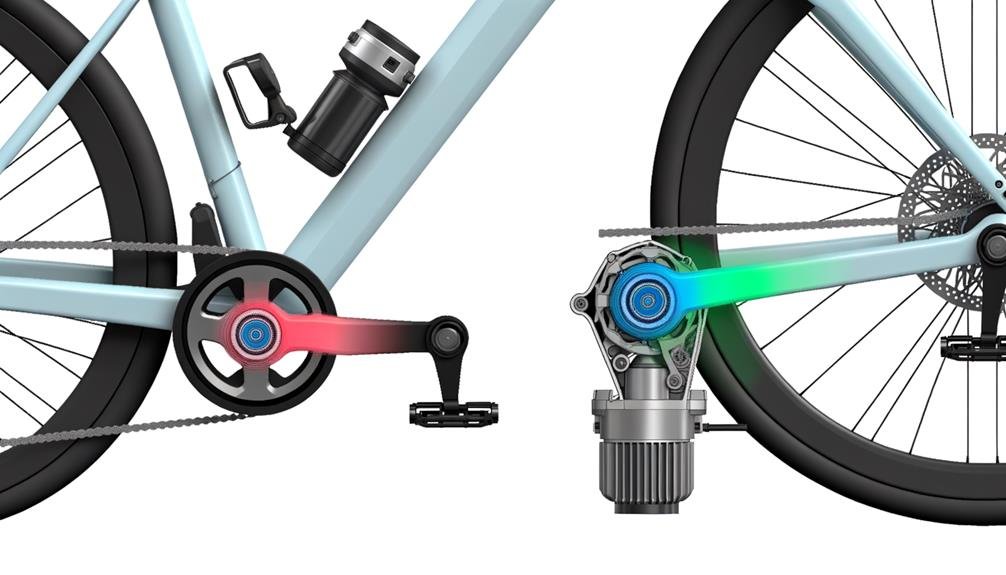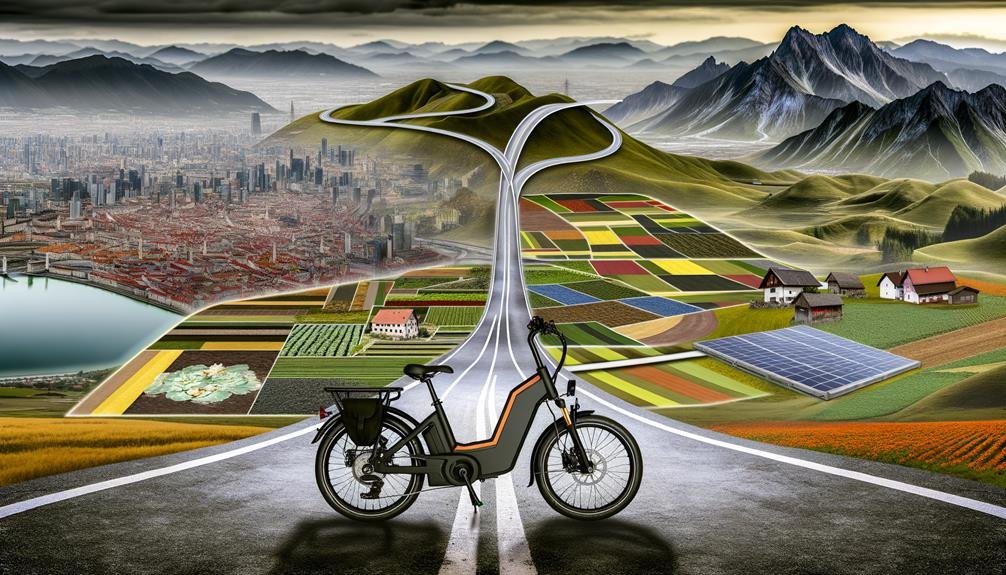Charles Miller is a veteran bike enthusiast with over 12 years of experience dealing with bikes as a mechanic. Despite immense love and expertise for...
In the days of the horse and buggy, who could have imagined a bicycle that could sense the force of its rider's pedaling and adjust its motor assistance accordingly? That's exactly what modern e-bikes do, thanks to the marvel of torque sensors.
These ingenious devices are crucial to e-bike operation, enhancing performance, efficiency, and enjoyment. Their workings may seem intricate and complex, but don't be put off – with a bit of unraveling, the mechanics of these sensors can be understood.
So why not join me as we pedal into the fascinating world of e-bike torque sensors and uncover their secrets?
Key Takeaways
- Torque sensors measure the force applied to the pedals in real-time and adjust the motor power accordingly.
- They provide a more intuitive and efficient riding experience compared to cadence sensors.
- Torque sensors are typically located in the bottom bracket and determine the motor's response based on the amount of force applied.
- They enhance performance, efficiency, and control, especially on challenging terrains, and revolutionize the e-bike riding experience.
Understanding Ebike Torque Sensors
When it comes to understanding Ebike torque sensors, it's essential to know that they measure the force you apply to the pedals in real-time, adjusting motor power based on your effort to provide a responsive and natural riding experience. Simply put, torque sensors use this data to ensure your electric bike responds instantly, making your ride smoother and less strenuous.
Now you might ask, 'how do ebike torque sensors work?' Well, they could be strain gauge, magnetic, or optical-based, each with different output signals, either analog or digital. Depending on the type, they detect the slightest changes in pedal pressure and translate it into varying levels of motor assistance.
Let me explain what a torque sensor does in comparison to a cadence sensor. While both are crucial parts of an ebike, a torque sensor offers a more intuitive and efficient riding experience, particularly for challenging terrains. It's like having an invisible friend who understands your effort and empowers you to conquer any hill with ease. In contrast, cadence sensors focus more on your pedaling speed, which can be beneficial but not as responsive as torque sensors.
In essence, understanding how these sensors work can enhance your ebike experience and make every ride a joy.
Mechanics of Torque Sensors
Let's talk about the mechanics of torque sensors.
First, we'll tackle the basics – how they measure the torque applied to the pedals and the role they play in your ebike's performance.
Then, we'll move on to more advanced functionalities and the different types of torque sensors available.
Understanding Torque Sensor Basics
To fully appreciate the mechanics of torque sensors in e-bikes, we need to understand that these sensors measure the force applied to the pedals, adjusting the motor's power output to match the rider's effort. These ebike torque sensors are typically located in the bottom bracket, the heart of your pedal power.
In understanding torque sensor basics, consider these three points:
- The amount of force you apply to the pedals determines the motor's response. More force equals more power.
- They offer a more intuitive ride, as the motor assistance matches your exertion, making it feel more like traditional biking.
- E-bikes with torque sensors are perfect for challenging terrains, as they give you greater control over your speed and power.
Advanced Torque Sensor Functionality
Diving deeper into the mechanics of torque sensors, we find that these advanced devices measure the force applied to the pedals in real time, adjusting the motor's assistance to match the rider's pedaling power for a more natural and efficient cycling experience.
Advanced torque sensor functionality means the harder you pedal, the more support you get. The ebike torque sensors read the force you apply to the pedals, adjusting the pedal assist level accordingly. This means you're part of a cycling community that values both efficiency and a natural ride feel.
The sensors make your ride smoother and more intuitive, amplifying your pedal power up to 300%. These sensors are designed for you, offering a responsive, fulfilling ride experience.
Cadence Vs Torque Sensors

When comparing cadence and torque sensors in e-bikes, it's essential to understand their distinct functions and advantages.
Cadence sensors detect the speed at which you're pedaling. They offer a predictable and cruise-control-like ride, where the level of assistance is predetermined based on your pedaling speed. It's a simpler, more affordable option, but it's worth noting that sensors tend to have a slight delay, which can make group rides a bit challenging.
On the other hand, ebike torque sensors measure the force you're applying to the pedals. They provide a more intuitive, responsive riding experience by adjusting the electric assist proportionally to your effort.
Some e-bikes use a hybrid approach, combining the instant feedback of torque sensors with the additional information from a cadence sensor. This setup provides intuitive power selection and deeper insights into your pedaling speed and shifting.
Importance of Torque Sensors
In my experience, the importance of torque sensors in e-bikes can't be overstated. They're key in enhancing performance, granting a more natural ride, and saving battery life.
Furthermore, they offer improved safety and control, particularly on difficult terrains.
Enhancing Ebike Performance
Let's explore how torque sensors, by measuring the force you apply to the pedals, significantly enhance an ebike's performance and efficiency, especially when navigating varying terrains.
Ebike torque sensors are vital for enhancing ebike performance. They transform your riding experience, making it more intuitive and responsive.
- Torque Sensors and Assistance Levels: The sensors adjust the assistance levels based on your pedaling power, leading to a more natural ride on electric bikes.
- Navigating Different Terrains: With torque sensors, you get increased power when required, making it easier to tackle varying terrains.
- Safety and Efficiency: These sensors enhance safety by providing the right amount of power when needed, improving overall efficiency.
In essence, torque sensors truly revolutionize the ebike riding experience.
Safety Through Sensing
Harnessing the power of torque sensors not only enhances the ebike's performance but significantly improves rider safety too.
When I start pedaling, the ebike torque sensors play a crucial role in gauging the effort from the rider. They then relay this information to the e-bike motors, adjusting the level of assistance accordingly.
This is how ebike torque sensors work to ensure safety through sensing. The sensors provide an intuitive riding experience, eliminating the need for manual adjustments. This leads to a smoother, more efficient ride, and it's also an excellent way to save battery power.
Choosing the Right Sensor

Choosing the right sensor for your e-bike involves considering several factors, such as your riding experience, the terrain you'll be riding on, your personal preferences, and the overall battery efficiency of the e-bike. Ebike torque sensors provide a more intuitive, responsive ride, while a sensor and a cadence system offer consistent, predictable assist levels.
To help you make the best e-bike selection, here are three considerations:
- Riding Experience: If you're seeking a natural, dynamic feel, torque sensors are a great choice. For consistent assistance, consider cadence sensors.
- Terrain and Riding Style: For hilly terrains and demanding rides, torque sensors excel. Cadence sensors are ideal for casual rides and flat terrains.
- Battery Efficiency: Torque sensors generally offer better battery range due to their detailed readings and rider input, while cadence sensors may have a more limited range.
Choosing the right sensor isn't just about technical specs, it's about finding the perfect riding companion. Whether you opt for torque sensors, cadence sensors, or a hybrid approach, remember that the best e-bike is the one that brings you the most joy and comfort on your rides.
Maintaining Your Ebike's Torque Sensor
Maintaining your e-bike's torque sensor is crucial for ensuring a smooth and efficient ride. It's not all about how hard you're pedaling or the e-bike model you're riding; the torque sensor plays a significant role. When you understand how ebike torque sensors work, you'll appreciate the need for regular maintenance.
The torque sensor uses a component called a strain gauge to measure the force you apply when pedaling. This information is crucial in regulating the amount of assistance your e-bike provides, affecting your overall riding experience. If you're experiencing slow starts, sudden stops, or a loud motor when switching speeds, these could be signs that it's time for a check-up.
Regularly maintaining your ebike's torque sensor involves more than just a quick wipe-down. Be careful during cleaning to avoid damaging the sensor. It's worth getting professional help for sensor issues; after all, we're all in this e-bike community together.
Frequently Asked Questions
Is Torque Sensor Worth It on a Ebike?
Absolutely, I find a torque sensor on an e-bike worth it. It makes my ride smoother and more responsive, especially on challenging terrains. It's like the bike understands my effort and adjusts accordingly.
How Do Torque Sensors Work?
Torque sensors work by measuring the force I apply to the pedals. They adjust the motor's power in real-time, providing a natural, responsive ride. It's like having a buddy who matches my effort, pedal for pedal.
What Is the Difference Between a Speed Sensor and a Torque Sensor?
When I pedal my ebike, the torque sensor measures my pedaling force to adjust motor assistance, providing a natural ride. On the other hand, a speed sensor bases assistance on how fast I'm pedaling, not force.
How Does an Ebike Cadence Sensor Work?
As an e-bike enthusiast, I'm intrigued by how cadence sensors work. They detect pedal speed, then signal the motor to kick in accordingly. It's simple, yet effective for a smoother, more enjoyable ride.
Conclusion
In a nutshell, e-bike torque sensors are the unsung heroes of the biking world. Without their magic, we'd be stuck in the dark ages of cycling, pedaling without purpose. They're the key to unlocking a smoother, more efficient ride, and are the lifeblood of your e-bike's battery.
So, don't under-estimate them – they're as vital as the wheels on your bike! Understand them, respect them, and your e-bike adventures will be nothing short of spectacular.

Charles Miller is a veteran bike enthusiast with over 12 years of experience dealing with bikes as a mechanic. Despite immense love and expertise for his Tacoma, he rides his Trek Ebike more. Anytime you meet him, you’ll either hear him talking about Bikes, or writing about all things bikes and cars on this blog.
More Posts


